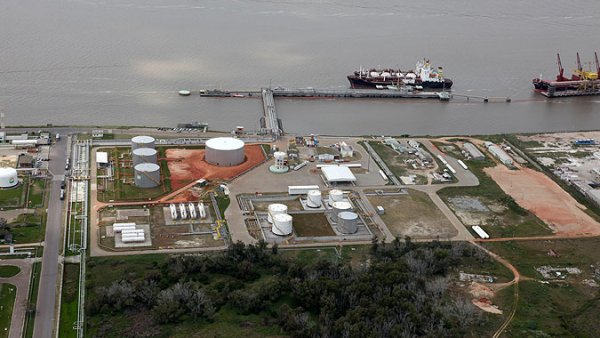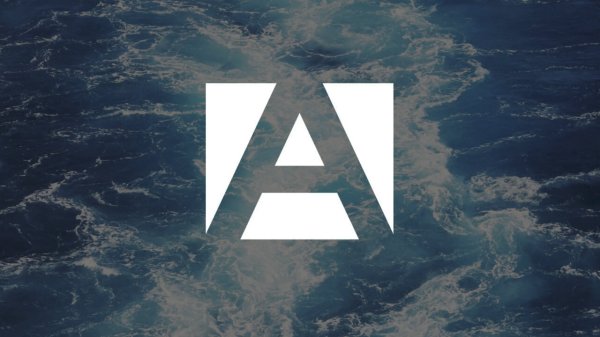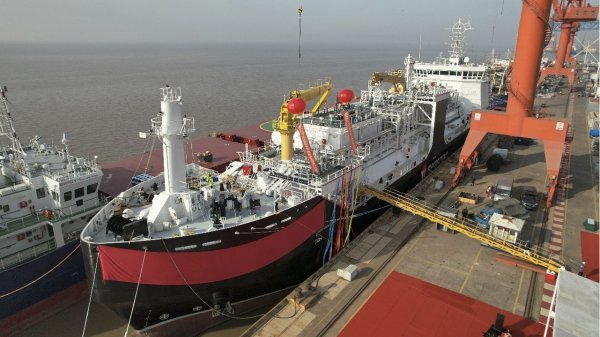California clamps down on methane leaks from oil and gas facilities
New regulation requires quarterly monitoring of methane emissions from oil and gas facilities.
The California Air Resources Board (CARB) on Thursday approved a new regulation aimed at curbing emissions of the powerful greenhouse gas that regularly escapes from oil and gas operations. The new rule is the most comprehensive of its kind in the United States.
Methane, one of the greenhouse gases called short-lived climate pollutants (SLCPs) and the main component of natural gas, has 72 times the impact on global warming as carbon dioxide.
The new regulation is expected to reduce methane leaks from oil and gas operations in California by the equivalent of 1.4 million metric tonnes of carbon dioxide annually, the equivalent of taking 280,000 cars off the road for a year. Locating and repairing leaks in oil and gas systems is expected to provide additional benefits in reducing smog-causing chemicals because the same leaks often release air toxins and volatile organic compounds, such as benzene.
"The Trump administration has backed away from efforts to develop a federal rule to curb methane leaks from existing facilities - the nation's largest source of methane pollution," said CARB Chair Mary D. Nichols. "California's regulations continue our leadership in fighting air pollutants and help meet our goal of reducing greenhouse gas emissions 40 percent below 1990 levels by 2030."
California's new air regulation requires quarterly monitoring of methane emissions from oil and gas wells, natural gas processing facilities, compressor stations and other equipment used in the processing and delivery of oil and natural gas. Some equipment will also be required to add vapor collection systems.
The new regulation adds to emergency regulations that were put in place by the Department of Conservation's Division of Oil, Gas, and Geothermal Resources after the methane leak in the Aliso Canyon natural gas storage field. Those regulations require additional monitoring and testing at all underground natural gas storage facilities, making it easier to prevent well leaks.
"This new tool to curb methane emissions complements the rigorous safety and inspection requirements now in place at all gas storage fields in California," said David Bunn, director of the Department of Conservation. "Not only is California working to prevent another major methane leak like the one at Aliso Canyon, it's important that we also reduce the cumulative impacts of smaller leaks."
Cliff Rechstschaffen, California Public Utilities Commissioner, said the regulation provides "valuable tools in California's continuing efforts to reduce greenhouse gas emissions and ensure safe utility infrastructure."
"It is another example of the State's international leadership in addressing climate change and other environmental issues," he added.
Although the largest source of methane in California is livestock, the oil and gas industry is estimated to be responsible for about 15 percent of the state's methane emissions.
Adoption of the oil and gas rule is a step towards implementing the Short-Lived Climate Pollutant Reduction Strategy, which provides guidance for development and implementation of California's overall effort to reduce these highly potent climate pollutants. SB 1383 (Lara, 2016) sets the target for statewide methane reductions of 40 percent below 2013 levels by 2030. The board adopted that plan on Thursday.
'Methane slip' from LNG-powered ships
Last year, the European Commission (EC) reported that emissions of unburnt methane (known as the 'methane slip') from LNG-powered ships were around 7g per kg LNG at higher engine loads, rising to 23-36g at lower loads. It was suggested that the increase could be due to slow combustion at lower temperatures, which allows small quantities of gas to avoid the combustion process.
"These escaped emissions are significant, as methane has a global warming potential which is 28 times higher than that for CO2 over a 100 year perspective, and 84 times higher over 20 years," the EC said.
Methane, one of the greenhouse gases called short-lived climate pollutants (SLCPs) and the main component of natural gas, has 72 times the impact on global warming as carbon dioxide.
The new regulation is expected to reduce methane leaks from oil and gas operations in California by the equivalent of 1.4 million metric tonnes of carbon dioxide annually, the equivalent of taking 280,000 cars off the road for a year. Locating and repairing leaks in oil and gas systems is expected to provide additional benefits in reducing smog-causing chemicals because the same leaks often release air toxins and volatile organic compounds, such as benzene.
"The Trump administration has backed away from efforts to develop a federal rule to curb methane leaks from existing facilities - the nation's largest source of methane pollution," said CARB Chair Mary D. Nichols. "California's regulations continue our leadership in fighting air pollutants and help meet our goal of reducing greenhouse gas emissions 40 percent below 1990 levels by 2030."
California's new air regulation requires quarterly monitoring of methane emissions from oil and gas wells, natural gas processing facilities, compressor stations and other equipment used in the processing and delivery of oil and natural gas. Some equipment will also be required to add vapor collection systems.
The new regulation adds to emergency regulations that were put in place by the Department of Conservation's Division of Oil, Gas, and Geothermal Resources after the methane leak in the Aliso Canyon natural gas storage field. Those regulations require additional monitoring and testing at all underground natural gas storage facilities, making it easier to prevent well leaks.
"This new tool to curb methane emissions complements the rigorous safety and inspection requirements now in place at all gas storage fields in California," said David Bunn, director of the Department of Conservation. "Not only is California working to prevent another major methane leak like the one at Aliso Canyon, it's important that we also reduce the cumulative impacts of smaller leaks."
Cliff Rechstschaffen, California Public Utilities Commissioner, said the regulation provides "valuable tools in California's continuing efforts to reduce greenhouse gas emissions and ensure safe utility infrastructure."
"It is another example of the State's international leadership in addressing climate change and other environmental issues," he added.
Although the largest source of methane in California is livestock, the oil and gas industry is estimated to be responsible for about 15 percent of the state's methane emissions.
Adoption of the oil and gas rule is a step towards implementing the Short-Lived Climate Pollutant Reduction Strategy, which provides guidance for development and implementation of California's overall effort to reduce these highly potent climate pollutants. SB 1383 (Lara, 2016) sets the target for statewide methane reductions of 40 percent below 2013 levels by 2030. The board adopted that plan on Thursday.
'Methane slip' from LNG-powered ships
Last year, the European Commission (EC) reported that emissions of unburnt methane (known as the 'methane slip') from LNG-powered ships were around 7g per kg LNG at higher engine loads, rising to 23-36g at lower loads. It was suggested that the increase could be due to slow combustion at lower temperatures, which allows small quantities of gas to avoid the combustion process.
"These escaped emissions are significant, as methane has a global warming potential which is 28 times higher than that for CO2 over a 100 year perspective, and 84 times higher over 20 years," the EC said.

|
IMO approves pricing mechanism based on GHG intensity thresholds
Charges to be levied on ships that do not meet yearly GHG fuel intensity reduction targets. |
|
|
|
||

|
VARO Energy expands renewable portfolio with Preem acquisition
All-cash transaction expected to complete in the latter half of 2025. |
|
|
|
||

|
NYK trials biofuel in milestone coal carrier test
Vessel is used to test biofuel for domestic utility company. |
|
|
|
||

|
H-Line Shipping orders LNG bunkering vessel
Vessel with 18,000-cbm capacity to run on both LNG and MDO. |
|
|
|
||

|
How to engineer and manage green shipping fuels | Stanley George, VPS
Effective management strategies and insights for evolving fuel use. |
|
|
|
||

|
Swedish government bans scrubber wastewater discharges
Discharges from open-loop scrubbers to be prohibited in Swedish waters from July 2025. |
|
|
|
||

|
MAN Energy Solutions achieves 100% load milestone for ammonia engine
Latest tests validate fuel injection system throughout the entire load curve. |
|
|
|
||

|
Petrobras secures ISCC EU RED certification for B24 biofuel blend at Rio Grande
Blend consisting of 24% FAME is said to have been rigorously tested to meet international standards. |
|
|
|
||

|
Stolt-Nielsen to fully control Avenir LNG with acquisition
Share purchase agreement to buy all shares from Golar LNG and Aequitas. |
|
|
|
||

|
Bureau Veritas supports launch of CIMC SOE's LNG bunkering vessel
Handover of Seaspan Energy's cutting-edge 7,600-cbm vessel completed. |
|
|
|
||
Related Links
- · California At-Berth Regulation advisory becomes effective in January 2017 [Insights]
- · Shipping firm fined $129,500 for not switching fuels [Insights]
- · DOE funds project to accelerate introduction of fuels for low-emission engines [Insights]
- · LA and Long Beach propose 'bold strategies' to slash emissions [Insights]

